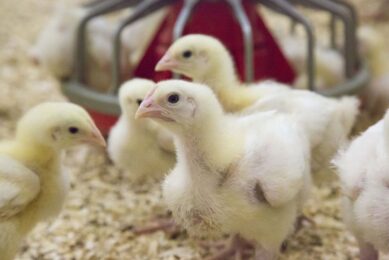Confronting antimicrobial resistance: building a resilient future

Finding new antibiotic treatments against bacteria and getting them to the point of use poses significant challenges, especially when combined with the growing threat of drug-resistant infection. It is thus vital that agriculture does everything in its power to reduce its contribution to the growth and spread of AMR.
Chicken and eggs are both high in protein and versatile, making them the main ingredient in many meals. This makes poultry one of the most-consumed meats worldwide, with estimated total consumption expected to reach 91 million tonnes by 2032. From this level of consumption, it is clear that poultry products are an important source of nutrition. However, raw chicken and eggs can be contaminated with pathogens that cause foodborne illness, such as Campylobacter, Salmonella and Clostridium perfringens. These bacteria can be spread to food products during slaughter and processing, causing foodborne infections. Such infections are a major food safety issue and public health concern.
Traditionally, these pathogens have been addressed with antimicrobial products but this practice has led to an increase in antimicrobial resistance (AMR). While AMR does occur naturally over time, the misuse and overuse of these tools in humans, plants and animal production has accelerated it. Like foodborne illness, AMR is a food safety issue, because resistant bacteria and resistance genes can spread from food animals to humans through the food chain. In fact, AMR is one of the top ten threats to global health. AMR means that infections become harder to treat, resulting in longer hospital stays and increased mortality; globally, 4.95 million deaths a year are associated with AMR and this could rise to 10 million per year by 2050 if no action is taken. AMR is also a huge economic burden. In the UK it is estimated to cost the National Health Service £180 million per year (US$229 million) and the estimated burden for the US is US$55 billion annually: US$20 billion for healthcare and US$35 billion for loss of productivity.
Awareness
Increasing awareness and concern regarding AMR have led many countries to ban the use of antibiotic growth promoters in animal feeds. However, these bans are not enough to stop the increased emergence of antimicrobial resistance as the rates of resistance are still high, despite restrictions on antibiotic use. In the latest European Union summary report on the topic (2021-2022), overall resistance among isolates from broilers and fattening turkeys to fluoroquinolones (ciprofloxacin) was very high (55.5% and 57.9%, respectively). It was also high in laying hens (24.7%). Resistance among Salmonella Kentucky isolates to ciprofloxacin in broilers, layers and fattening turkeys was extremely high (84.2%, 82.1% and 100%, respectively). This underscores AMR as a significant food safety issue.
Therefore, it is vital that we find ways to reduce resistance and increase bacterial sensitivity to antibiotics. It is clear there is no ‘silver bullet’ to prevent and control the spread of AMR in poultry production, hence a multifaceted approach will be needed to address the issue. This approach should include:
- Improved biosecurity, stringent sanitation and careful waste management
- Reduced antibiotic usage, under veterinary supervision
- No antibiotic growth promoters
- A strong vaccination programme, disease surveillance and vector control
- Good nutrition
- Alternatives to antibiotics and improved gut health
Mannan-rich fraction
Alternatives to antibiotics generally look at improving gut health and the microbiome of the bird. This is true for Alltech’s yeast-cell-wall-derived mannan-rich fraction (MRF) which has been shown to support birds’ performance and health as an alternative to antibiotics, through modulating the microbiome, binding pathogenic bacteria and promoting gut health. However, recent research has shown that MRF can additionally impact bacterial susceptibility to antibiotics.
 While early research focused on MRF’s ability to control pathogens such as Salmonella and E. coli, improve intestinal health and enhance the diversity of the intestinal microbiome, more recently published research (Smith and others, 2017; Smith and others, 2020) has focused on the effect of MRF on antibiotic-resistant bacteria. The latest published research (Smith and others, 2022) showed the effect of MRF supplementation on the growth of antibiotic‐resistant E. coli with and without antibiotic treatment relative to a control culture. They found that MRF significantly reduced this growth of antibiotic‐resistant E. coli relative to the control culture by 46%, and that MRF in combination with antibiotic treatment (AMP, ampicillin) had an added growth reduction of 73% in antibiotic‐resistant E. coli relative to the control (Figure 1). This indicates that the use of MRF enhances the sensitivity of resistant bacteria to the effects of antibiotics.
While early research focused on MRF’s ability to control pathogens such as Salmonella and E. coli, improve intestinal health and enhance the diversity of the intestinal microbiome, more recently published research (Smith and others, 2017; Smith and others, 2020) has focused on the effect of MRF on antibiotic-resistant bacteria. The latest published research (Smith and others, 2022) showed the effect of MRF supplementation on the growth of antibiotic‐resistant E. coli with and without antibiotic treatment relative to a control culture. They found that MRF significantly reduced this growth of antibiotic‐resistant E. coli relative to the control culture by 46%, and that MRF in combination with antibiotic treatment (AMP, ampicillin) had an added growth reduction of 73% in antibiotic‐resistant E. coli relative to the control (Figure 1). This indicates that the use of MRF enhances the sensitivity of resistant bacteria to the effects of antibiotics.This research also demonstrated that the use of MRF, with or without antibiotics, led to the upregulation of TCA-cycle proteins in the resistant E. coli. These proteins are upregulated under conditions of oxidative stress and antibiotic stress. In addition, MRF increased the formation of reactive oxygen species (ROS) in resistant E. coli by 42% relative to the control and when MRF was combined with antibiotics, the increase was 59% (Figure 2). ROS play a role in microbial metabolism and response to environmental stressors. Therefore, these increases in TCA-cycle proteins and ROS production may be linked to more efficient bactericidal effects and the change in the antibiotic susceptibility of the resistant organism.
Robust holistic approach
 With chicken and eggs being at the heart of many meals globally every day, it is tremendously important that the food produced by the poultry industry is safe. This is crucial to reducing foodborne infection from Salmonella, Campylobacter and E. coli, thereby decreasing mortality, alleviating the economic burden and reducing the potential spread of AMR from agriculture to the human population.
With chicken and eggs being at the heart of many meals globally every day, it is tremendously important that the food produced by the poultry industry is safe. This is crucial to reducing foodborne infection from Salmonella, Campylobacter and E. coli, thereby decreasing mortality, alleviating the economic burden and reducing the potential spread of AMR from agriculture to the human population.Adopting a robust, holistic approach to increasing food safety in poultry production is vital and using innovative solutions like MRF can help in achieving the goal of reducing the prevalence of resistant bacteria and safeguarding public health. Mannan-rich fraction (MRF) has demonstrated that it works in three complementary ways to help achieve this goal: supporting the microbiome and gut health of the bird, making antibiotic use less necessary, boosting the efficiency of antibiotics when they are needed and thus helping to decrease the prevalence of resistant bacteria. This together helps the agricultural sector to reduce its contribution to the growth and spread of AMR.












